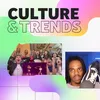YouTube’s Culture & Trends Report: The Rise of Personally-Relevant Pop Culture
Today, we’re launching a new global YouTube Trends report focused on Gen Z viewers and creators.
Jun 22, 2022 [[read-time]] minute read

Jun 22, 2022 [[read-time]] minute read
Throughout the pandemic, we analyzed trends on YouTube to better understand the impact of video. We discovered that video can create a powerful sense of connection, which makes it an indispensable part of our lives.
This year we turned our focus to Gen Z creators and viewers to see their impact and how they’re driving the evolution of trends. For our latest report, we conducted surveys in more than 10 countries and analyzed hundreds of trends to find what cuts through in pop culture today.
65 percent of Gen Z agree that content that’s personally relevant to them is more important than the content that lots of other people talk about
We found that digital culture is now all about personally-relevant content. In fact, 65 percent of Gen Z (online 18-24 year olds) agree that content that’s personally relevant to them is more important than the content that lots of other people talk about. Individual viral videos — the Davids, Charlies, and, yes, even foxes that broke through in the past — are becoming increasingly less central to trends in a world where audiences and creators prioritize moments that matter to them and their lives.
Of all the trends we looked at and the data we pulled, three specific types of creativity emerged at the core of this new, personally-relevant pop culture: Community creativity, multi-format creativity, and responsive creativity. Here’s a quick look at how each of those plays a key role:
Communities are building conversations online by taking niche passions and turning them into larger, shared experiences. Consider Big Jet TV, which became a national sensation this year when nearly a quarter of a million viewers tuned in to watch creator Jerry Dyer’s live coverage of planes trying to land at Heathrow during Storm Eunice’s high winds. It was the perfect example of people coming together around an unlikely common interest to turn it into a much larger community moment.
Trending concepts are showing up across a more diverse range of mediums and formats than ever before. We see this in the increasing interplay between short-form and long-form content on YouTube, which has led to the rise of Multi-format Creators, who can seamlessly move from one format to another. Some of the most popular rising Shorts creators, like Lisa Nguyen and Nick DiGiovanni, have found success by also producing longer material that their audiences can explore in greater depth. Popular creators, like MrBeast and The Sorry Girls who are known for their long form videos, are also leaning into Shorts and reaching new audiences as well.
Formats that play into emotional needs like “comfort creators,” vibe content and ASMR, continue to evolve.
At the start of the pandemic, we noticed that people were turning to video to meet specific personal needs. This continues to hold true — and grow — today: 83 percent of Gen Z have used YouTube to watch soothing content that helps them relax, an increase from when we ran our survey a year ago. As a result, formats that play into these emotional needs like “comfort creators,” vibe content and ASMR, continue to evolve.
Even the Victoria and Albert Museum couldn’t resist joining in on the trend, with their recent series of ASMR at the museum videos.
If there’s one thing that our research has made clear, it’s that pop culture is undergoing another shift. While there’s much to digest here, we hope that our report can provide some context and insight into the dynamics behind that shift. Be sure to check out the full Trends Report for more detail on our research.